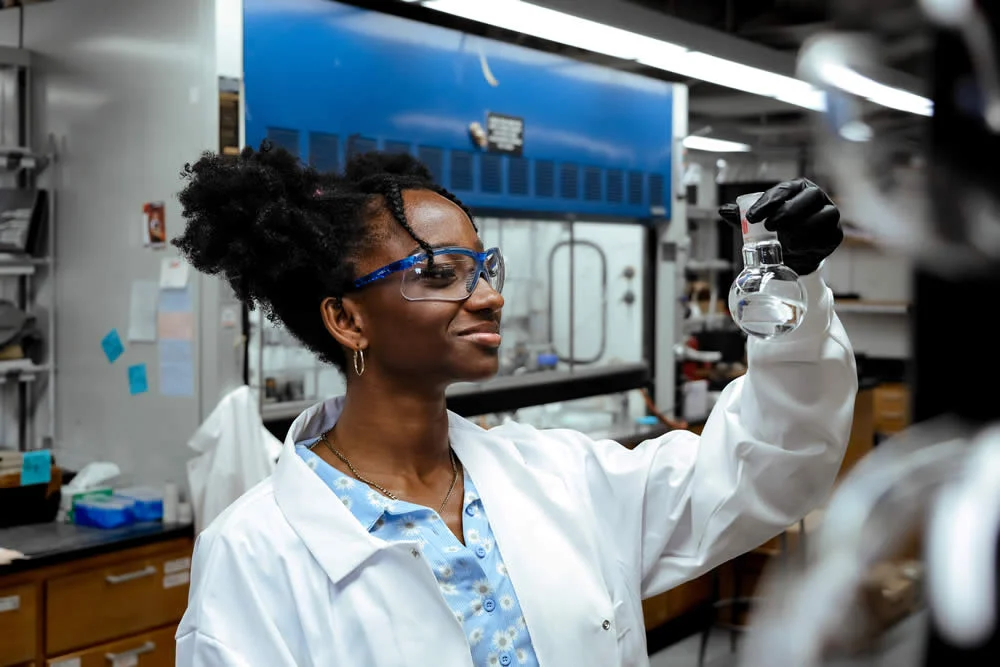
Julianna Cox of Park Forest is a graduate of Crete-Monee High School and a senior Chemistry and Biology major at Mississippi Valley State University (MVSU) (PHOTO SUPPLIED)
Courtesy of Daniel Dassow, REU Science Writer
Cox traveled to the University of Tennessee, Knoxville, where she participated in Research Experiences for Undergraduates (REU), a highly selective program in the Chemistry Department funded by a National Science Foundation grant.
She was one of only ten students selected from universities nationwide to conduct cutting-edge chemistry research at UT Knoxville. The program matches students to professors whose work aligns with their interests and gives them a glimpse of life as a scientist.
“Out of 80 applicants, it was only five spots for women and five spots for men, so it was ten of us total. When the director told me that I was one of the ten people selected, I was ecstatic,” said Cox.
Cox worked full-time in the lab of Professor Tessa Calhoun, where researchers shot ultrafast lasers at microscopic particles to study complex interactions at their surfaces.
Laser is an acronym for “light amplification by stimulated emission of radiation,” and there are many different kinds. Continuous-wave lasers, like the red pointers used by teachers or by kids playing with pets, emit only one frequency of light and are less powerful than pulsed lasers, which emit an ultrafast beam.
To the naked eye, the red laser beams in Professor Calhoun’s lab may look similar to a commercial laser pointer. However, the pulsed lasers used in the lab are much more powerful and emit light so quickly that the time between each pulse is measured in femtoseconds or quadrillionths of a second.
The lab’s two lasers are also part of large systems that include hundreds of pieces of optical equipment, from mirrors to filters to prisms and lenses, which can be calibrated to amplify, split, compress, disperse, and reflect or filter the beam as needed for each experiment.
For her research, Cox grew living cultures of staphylococcus, the bacteria that causes life-threatening staph infections and can develop antibiotic resistance. The big picture goal of shooting live bacteria with ultrafast lasers is to better understand how the structure of a molecule impacts its behavior in a cell membrane.
To understand how the structure of molecules may affect their ability to permeate and kill bacteria, Cox added an orange-colored dye to the bacteria sample, which helps make the invisible visible when shot with a laser.
She then flowed her dyed sample through a small piece of almost perfectly clear quartz. When an ultrafast laser beam strikes dye molecules through the quartz, the molecules undergo a process called a second harmonic generation (SHG), the centerpiece of Cox’s research.
During SHG, two particles of light called photons with equal frequencies collide with a dye molecule and send it into a high-energy excited state. When the dye molecule exits the excited state and returns to its original ground state, it spits the energy from the two red photons back out in the form of one blue photon.
The intensity of this release of blue light tells researchers like Cox about the position of the dye molecules relative to the membranes of the staph bacteria.
By adjusting the structure of the dye molecules, say by adding or subtracting a few atoms of carbon, researchers hope to find which chemical ingredients an antibiotic need to best stop bacterial pathogens in their tracks.
As a double Chemistry and Biology major at MVSU, a historically Black college, Cox has served as a resident assistant, an ambassador for the Office of International Programs and an active member of the Louis Stokes Alliances for Minority Participation (LSAMP), a program that supports minority students as they conduct STEM research.
She is accustomed to the task of learning a completely new lab environment, having completed a different research internship nearly every summer since she was in high school in the Park Forest area. She said Professor Calhoun’s lab pushed her to the edge of what she thought was possible.
While she was at UT, Cox took time to meet leading professors in the Chemistry Department and the Biology Department. “I’m using this time to meet people, to network with professors, and build up a foundation before I apply to Ph.D. programs,” she said.
Thanks to a partnership between the REU program and the Judith Anderson Herbert Writing Center at UT, Cox could hone her public speaking and writing skills through a series of professional communication workshops culminating in a final research presentation. As she prepares to graduate this fall and apply to graduate school, Cox hopes to find a program where she can combine her passions for biology and chemistry to help solve complex environmental problems. With her history of interdisciplinary excellence at the edge of what’s possible, she is sure to be an asset wherever she lands.
Daniel Dassow is an REU (“Research Experience for Undergraduates”) Science Writer and Editor-in-Chief at The Daily Beacon at the University of Tennessee, Knoxville. Follow him on Twitter @danidassow.
